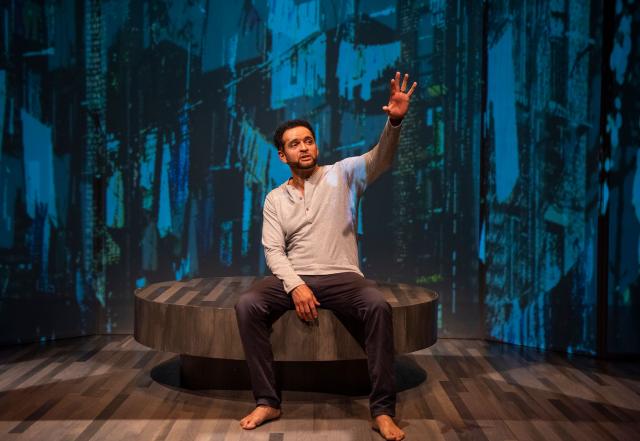

It has been a long, winding pandemic journey for the exquisitely crafted and performed Antonio’s Song/I was Dreaming of a Son, which opened recently in the Milwaukee Repertory Theater’s intimate Stiemke Studio. According to Artistic Director Mark Clements, who directs this piece, this co-production between the Rep and Contemporary American Theater Festival (CATF) was originally scheduled to open at the Rep in March 2020. In 2019, the show had already completed its world premiere at CATF, a nationally prestigious festival of new work located at Shepherd University in Shepherdstown, WV. But then, of course, the pandemic hit, and the performing arts world changed in unprecedented ways.
The Milwaukee Rep already had been familiar with the mercurial vision of playwright and Pulitzer Prize finalist Dael Orlandersmith, having produced two of her productions in past seasons: Yellowman and Until the Flood. Also, the Rep commissioned her to create a new work that will be debuting later this spring.
Antonio’s Song is an honest and empathetic look at fatherhood and the forces that shape a man’s identity. The one-man show also takes a hard look at the intersection of masculinity, violence, and ethnicity. It describes the intricate dance done by multi-racial children who fail to be fully accepted by the prevailing social order. The play asks big questions, such as: What is a man? What is a father?
The play takes place in many environments, which are projected onto screens surrounding a small, round, wood-topped platform (set design by Luciana Stecconi). One sees the worn brick facades of a Brooklyn neighborhood, with clotheslines hanging from every window. There are crashing waves to represent the ocean, when Suarez, as a teen, takes a job as a lifeguard. There are the tall, concrete pillars of Harvard University’s library. There is a flower-filled set in the main room of a funeral parlor. Complementing the set is lighting (by John Ambrosone), sound (by Andre Pluess), and projections (by Jared Mezzocchi).
By the final scenes, the main character has found liberation in an environment very far from the Brooklyn neighborhood where he grew up. At first, he attempts a complete break with his past, seeing only the heartache and dashed dreams of his “homies,” as well as within his own family. But family ties eventually draw him back into the fold – temporarily, at least.
Looking back on his life, Suarez struggles with ideas on how to “break the chain of abuse” so it won’t be repeated within his own family.
Antonio Edwards Suarez is at the heart of this piece, which constantly moves within the forces that affected his life. He gives audiences a strong impression of his mother (a polio-stricken, chain-smoking Latina) and father (a Black gun dealer who is often sidelined by the recurrent symptoms of sickle cell disease). Together, they raise a family that doesn’t seem to rise much above the poverty line.
With charisma and charm, Suarez recreates many others in his life, which include classmates, a younger sister, neighborhood kids, an uncle, a dance teacher, and even the famed Russian ballet dancer, Mikhail Baryshnikov. Seeing Baryshnikov perform on TV lightens something inside Suarez. He bounds around the living room, attempting to mimic the master. This is one of the play’s most humorous sequences, but it is also touching.
In fact, Suarez grows up to graduate from college, earning a scholarship to Harvard. He eventually gets his MFA degree, but not before traveling abroad to learn more about dance in Russia.
Then he marries and, eventually, the marriage produces a son. Suarez reflects on how he dreamt of his child for years before it was even born. Now, he attempts to see the world through the eyes of his 5-year-old son. One day, when the boy acts the way noisy youngsters do, Suarez reaches out and shakes his son before slapping him across the face. Horrified, Suarez releases his son. He reaches out to comfort the child, not precisely knowing why such behavior came so naturally to him.
The writing here is sharp and precise; anyone who has been a parent can relate to Suarez’ thoughts and feelings.
But Antonio’s Song offers much more. This is an opportunity to see a well-trained actor at the top of his craft. For 90 minutes (without intermission), Suarez takes the audience into his world. He does it with a particular sense of grace that is visualized by movement throughout. While Antonio’s Song may be difficult to describe, it is amazing to watch. Without a doubt, this is a show worth waiting for.
